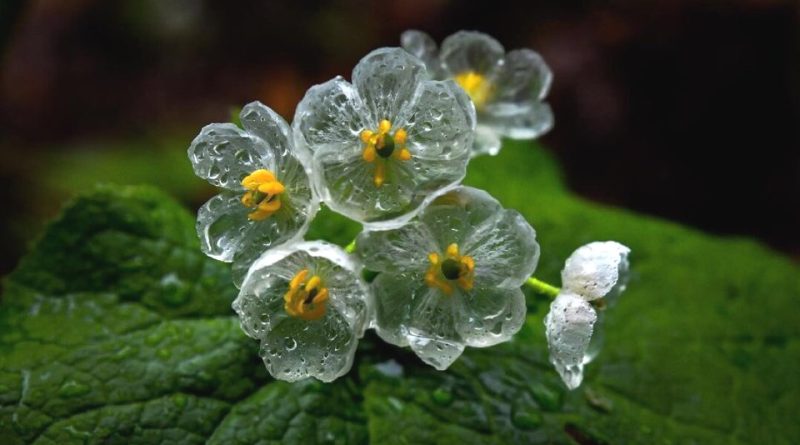Diphylleia grayi
Diphylleia grayi
Skeleton flower (Diphylleia grayi F.Schmidt) is a herbaceous species with a woody base of the Berberidaceae family.
Systematics –
From a systematic point of view it belongs to:
Eukaryota domain,
Kingdom Plantae,
Subkingdom Tracheobionta,
Spermatophyta superdivision,
Magnoliophyta division,
Class Magnoliopsida,
Subclass Magnoliidae,
Order Ranunculales,
family Berberidaceae,
Genus Diphylleia,
Species D. grayi.
The terms are synonyms:
– Diphylleia cymosa subsp. grayi (F.Schmidt) Kitam.;
– Diphylleia cymosa var. grayi (F.Schmidt) Maxim.;
– Diphylleia cymosa var. incisa (Takeda ex Takeda & Tanabe) T.Shimizu;
– Diphylleia grayi f. incisa Takeda & Tanabe;
– Podophyllum grayi (F.Schmidt) Christenh. & Byng.
The following varieties are recognized within this species:
– Diphylleia grayi var. grayi;
– Diphylleia grayi var. incisa (Takeda ex Takeda & Tanabe) T.Shimizu.
Etymology –
The term Diphylleia comes from the Greek dís, double, and phýllon, leaf. These plants always have only two leaves.
The specific grayi epithet was attributed in honor of the American botanist Asa Gray (1810-1888).
Geographic Distribution and Habitat –
Diphylleia grayi is a plant native to northern and central Japan and is distributed from north to central Honshu, Hokkaido, Mount Daisen and Sakhalin.
The plant is also present in the mountainous areas of China, Japan and the Appalachian mountains in the United States, where they germinate in the high altitude forests.
Its habitat is that of slightly humid places in the woods of the coldest high mountain regions.
Description –
Diphylleia grayi is a herbaceous perennial plant growing to about 0.4 m.
This plant forms tufts of large leaves, umbrella-shaped, are peltate, broadly rounded, bilobed at the apex and of an intense green colour. They also have various ribs and an irregularly indented edge.
In winter the plant loses its leaves but the root survives under the ground to resume its vegetative activity as soon as the temperatures become mild.
These are topped with small clusters of white flowers, consisting of six petals, which bloom from June to July. When it rains on the flowers they become translucent and then return to their original white color when they dry.
In late summer, stalks of eye-catching cobalt blue fruit replace the withered flowers.
After flowering, the plant produces dark blue-purple fruit with a powdery white coating.
Cultivation –
Diphylleia grayi is a perennial plant which is also harvested in its natural state for local use as food.
It is a plant that does not like hot summer temperatures, so it can be placed in suitable contexts and habitats.
Characteristic, as mentioned, is the ability of the flowers to become transparent but, although the white pigment of the flowers “vanishes” with water, these are not damaged in any way by the rain and, once dry, they return perfectly white as they were before transformation.
For its cultivation, in addition to the humidity characteristics of the climate, it prefers a humid peaty soil and partial shade and grows well in a wooded habitat.
The plant propagates by seed. This must be sown as soon as it is ripe. The seed is very slow to germinate, usually taking a year or more.
For this reason stored seeds should be sown as soon as possible.
Once germinated, the seedlings are to be placed in individual pots and transplanted in the open field in late spring or early summer, provided the climate is sufficiently humid.
It can also reproduce by division in spring.
Customs and Traditions –
Diphylleia Grayi is one of the most beautiful and characteristic plants due to its incredible characteristic in which the flowers become transparent with rain and humidity and then return to the original white color when the events cease.
The viewer thus has the impression that the flower has become glass or crystal, very light and impalpable, a beauty that could disappear at any moment. In reality, water has no real effect on the petals: the phenomenon, in fact, as mentioned, is absolutely reversible and, once dried, the flower becomes white again exactly as before.
According to the information contained in some reports, the fruits are edible while no medicinal uses are known.
South Korean artist Jonghyun, a member of boy band Shinee, wrote and released a song titled “Diphylleia Grayi” in 2015 as part of his album Story Op.1. The composition “Diphylleia Grayi” uses the metaphor of the double leaf as the personification of internal and external struggle. In September 2015, Jonghyun presented his book Skeleton Flower: Things That Have Been Released and Set Free.
Method of Preparation –
Diphylleia Grayi is one of the most characteristic plants from a choreographic point of view but it does not have great uses from a food point of view, except for the edibility of the fruit, nor for medicinal purposes.
Guido Bissanti
Sources
– Acta Plantarum – Flora of the Italian Regions.
– Wikipedia, the free encyclopedia.
– GBIF, the Global Biodiversity Information Facility.
– Useful Tropical Plants Database.
– Conti F., Abbate G., Alessandrini A., Blasi C. (ed.), 2005. An annotated checklist of the Italian vascular flora, Palombi Editore.
– Pignatti S., 1982. Flora of Italy, Edagricole, Bologna.
– Treben M., 2000. Health from the Lord’s Pharmacy, Advice and experiences with medicinal herbs, Ennsthaler Editore.
Photo source:
– https://inaturalist-open-data.s3.amazonaws.com/photos/47030481/original.jpg
Attention: The pharmaceutical applications and alimurgical uses are indicated for informational purposes only, they do not in any way represent a medical prescription; we therefore decline all responsibility for their use for curative, aesthetic or food purposes.


